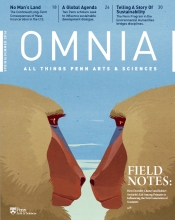Animals use specialized neurons in their brain known as grid cells to keep track of their physical location. The subject of the 2014 Nobel Prize in Physiology or Medicine, they earned that name because, when researchers monitored an individual grid cell in a moving rat, mapping the places where the neuron fired produced a regular triangular grid.
However, the way grid cells encode and decode this information to produce a usable mental map is still a mystery. Individual grid cells don’t differentiate between the points on their corresponding grids; to the brain, each point looks like the same burst of electricity. How can the brain translate those signals into something that says, “you are here?”
Researchers now have a theory for how grid cells work together to allow a rat—or a person—to accomplish this task.
By digging into the fundamental mathematics of the grids they encode, Vijay Balasubramanian, the Cathy and Marc Lasry Professor in the Department of Physics and Astronomy, and Xue-Xin Wei, GR'15, have shown that grid cells form a kind of number system, with different-sized grids acting as the equivalent of the ones, tens, hundreds, and thousands place in a decimal number.
They used this theory to make a key prediction—that different sized grids would be found in ratios based on the “transcendental” mathematical constant e—which has been borne out by evidence gleaned from earlier experiments.
In collaboration with Jason Prentice of Princeton University, they published their theory in the journal eLife. Partly for his work on this subject, Wei received the 2015 Louis B. Flexner Award for Outstanding Thesis Work in Neurosciences.
“What’s been clear for the last decade or so is that grid cells will respond when you are in one of several places, which form a triangular grid if you were to plot it on a map,” Balasubramanian says. “Each grid cell is responsible for maintaining one grid, and other cells are responsible for maintaining grids with different orientations or scales. So the mystery has been to figure out how the brain can use the overlap between these different grids to figure out where you are.”
Wei and Balasubramanian figured that the brain must have some sort of indexing system to relate the position on multiple grids of different sizes; combining that information is what gives an organism a good sense of where it is on a given mental map. Just as it would be massively inefficient to have a unique numeral for every number from 1 to 1,000, the researchers theorized that grid cells also use something like the decimal system, exploiting grids with different sizes.
A specific location could be represented by a series of grid cells, with each contributing a “digit” to the overall “code,” getting more and more precise by moving from cells that represent larger to smaller grids.
“Each grid cell’s firing represents a number of different locations, just like saying a number that has a five in the ones place doesn’t by itself tell you what the number is,” Balasubramanian says. “Our proposal is that grid cells are essentially a two-dimensional number system, so when they fire, they are collectively making a number out of the values in each of the different grids—just like 135 is a one in the hundreds place, a three in the tens, and a five in the ones.”
The next step was to determine what base this number system would use, given that it was a product of evolution rather than human ingenuity, like the decimal system base 10, or binary’s base 2. The researchers showed that, if evolution selected for the most amount of information using the least amount of cells, it would use something based on the mathematical constant e, or Euler’s number.
Like pi, e is transcendental, meaning, among other things, that its decimals trail off into infinity without repeating patterns. Also like pi, e is found everywhere in nature, but rather than describing the ratio between a circle’s diameter and its circumference, it is the basis for logarithms, exponential functions, and normal distributions, otherwise known as bell curves.
“It’s as if evolution figured out a deep theorem in number theory,” Balasubramanian says. “That’s what is beautiful about all this from a conceptual standpoint.”
For animals navigating a two-dimensional map, Balasubramanian and Wei predicted that the digits in the grids’ code would be related in square-root-of-e increments. Looking at actual grids derived from experiments with rats, this prediction was borne out: There are clusters of cells that represent grids that are successively square-root-of-e larger than one another, just like the digits in the tens place are ten times bigger than the ones.
“The crucial aspect is that this connects grid cells of different scales,” Wei says, “which allows you to solve the problem of figuring out where you are. So far, researchers have measured five grid scales in rats, but we predict they are going to find about 10. We think a 10-digit number is what you need to represent the 50 to 100 meters that make up the natural homing range of a rat.”






